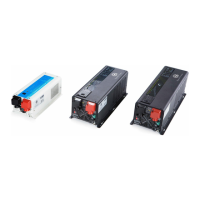www.sigineer.com
17
While for some resistive loads which work in a wide voltage range, the input AC range can be customized to
160-264VAC for 120/240Vac split phase models (90-135V for 120Vac models), this helps to power loads
with the most AC input power without frequent switches to the battery bank.
In order to make the inverter accept dirty power from a generator, when the SW2 is switched to position “1”,
the inverter will bypass an AC input with a wider voltage and frequency (40Hz plus for 50Hz/60Hz).
Accordingly, the AC charger will also work in a wider voltage and frequency range (43Hz plus for
50Hz/60Hz).
This will avoid frequent switches between battery and generator. But some sensitive loads will suffer from
the low quality power.
The pros and cons should be clearly realized.
SW3: Power Save Override ON/OFF
Under the Battery Priority Mode (SW5 in position “1”), the inverter can be switched between two modes:
Power Saver Mode (SW3 in position “1”) and Unit Off Charging Mode (SW3 in position “0”). The power
Switch should be in “Power saver on” position all the time for using these functions.
In Power Saver Mode, the inverter is initially in standby mode and sends a pulse to detect the presence of a
load every 3 seconds. Each pulse lasts for 250ms. The inverter will remain in standby mode until a load has
been detected. Then it will wake up from standby mode and start to invert electricity from the battery bank
to supply the load. As this function is under Battery Priority, the inverter will always prefer to invert
electricity from battery first even there is a qualified AC input present. Only when the battery voltage is
lower than the low voltage alarm point, will the inverter switch to AC input power to charge the battery and
supply the load at the same time.
This Power Saver Mode can be changed to Unit Off Charging mode via SW3 by switching it to “0” position
(SW5 still in “1”).
“Unit Off Charging” will enable the inverter charger to charge batteries as much as possible while without
discharging them.
In “Unit Off Charging” mode, the inverter will stay in standby mode without sensing loads. It won’t output
any power even if a load is turned on, and only stay idle in this mode when there is no AC input.
When a qualified AC input is present, it will start charging the battery and transfer power to loads.
This feature is ideally suitable for applications where energy conservation for batteries is required.
Charging will be activated once qualified AC exists, while discharging is disabled.
The inverter only consumes as little as 3 watts in “Unit Off Charging” mode.
SW4: Output Frequency
The output frequency of the inverter can be set at either 50Hz or 60Hz by SW4 which make the inverter
charger an international models for most electricity systems.
SW5: AC/Battery Priority
The Sigineer Power inverter chargers are designed with AC/Battery priority switch (DIP switch #5).
Switch the battery priority selector to Position “0” for AC priority mode, Position”1” for battery priority
mode. In AC priority mode, when AC input is present, the battery will be charged first, and the inverter will
transfer the input AC to power the load. Only when the AC input is stable for a continuous period of 15 days
will the inverter start a battery inverting cycle to protect the battery. After one normal charging cycle is
completed, ac power bypass will be restored.
When you choose battery priority, the inverter will invert from battery despite the AC input.
When the battery voltage reaches the low voltage alarm point higher than “Low Battery Trip Point” (the
gap between low battery alarm and cut off is 0.5Vdc for 12Vdc, 1Vdc for 24Vdc, 2V for 48Vdc), the
inverter will transfer to AC input, charge battery, and switch back to battery when the battery is fully
charged. This function is mainly for wind/solar systems using utility power or generator as back up.

